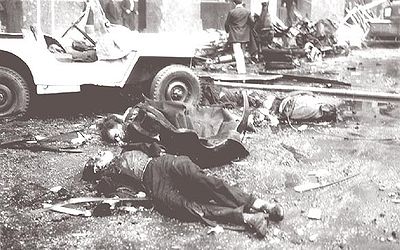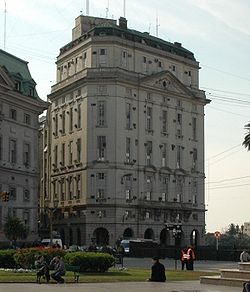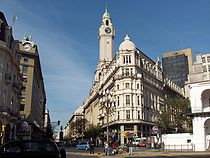
Plaza de Mayo
Encyclopedia
The Plaza de Mayo (ˈplasa ðe ˈmaʝo, May Square) is the main square in downtown Buenos Aires
, Argentina
. It is flanked by Hipólito Yrigoyen, Balcarce, Rivadavia and Bolívar streets.
Since being the scene of the 25 May 1810 revolution
that led to independence, the plaza has been a focal point of political life in Argentina.
's foundation of Buenos Aires itself, in 1580.
Newly arrived to the dusty riverbank settlement, Jesuit clergymen in 1608 secured a title to much of the 2 hectare (5 acre) lot, on which Garay's earlier plans for a central plaza had been abandoned. In 1661, the local governor purchased the eastern half for inclusion into the grounds of the city's new fort; this section soon became the Plaza de Armas.
Following over a century of overuse and neglect, the local colonial government attempted to give a semblance of order to the plaza by having a colonnade built across it from north to south. Completed in 1804, the Romanesque
structure became the plaza's market and the lot to the west of the colonnade became the Plaza de la Victoria.
The area continued divided between these two plazas until 1883 and with only minor changes in landscaping, chief among them the 1811 addition of the May Pyramid, a monument put up to commemorate the newly independent "Provinces of the Rio de la Plata". That year, however, Mayor Torcuato de Alvear
ordered the space modernized, resulting in the demolition of the colonnade and the creation of the modern Plaza de Mayo.
360º view of Plaza de Mayo, Buenos Aires
Other 360° view of Plaza de Mayo in Buenos Aires
 The Plaza de Mayo has always been the focal point of political life in Buenos Aires. Its current name commemorates the May Revolution
The Plaza de Mayo has always been the focal point of political life in Buenos Aires. Its current name commemorates the May Revolution
of 1810, which started the process towards the country's independence from Spain
in 1816.
in the Plaza de Mayo organized by the CGT trade union
federation forced the release from prison of Juan Domingo Perón, who would later become President of Argentina; during his tenure, the Peronist
movement gathered every October 17th in the Plaza de Mayo to show their support for their leader (and October 17 is still "Loyalty Day
" for the traditional Peronists). Many other presidents, both democratic and military, have also saluted people in the Plaza from the balcony of the Casa Rosada.
The plaza, in an attempt to overthrow President Perón, was bombed
during one of the populist leader's many rallies there on 16 June 1955, killing 364.
.jpg) Years later, in 1974, Perón, then president for the third time, expelled from the Plaza members of the Montoneros
Years later, in 1974, Perón, then president for the third time, expelled from the Plaza members of the Montoneros
, an armed organisation on the far left that had contributed to the aging leader's return from exile the previous year and had since demanded influence within the national government. Perón's final appearance at the plaza, on 12 June, was marked by an acrimonious break with the far left, leading to two years of violence and repression and, ultimately, a coup d'état
.
Crowds gathered once again on April 2, 1982 and several occasions thereafter to hail de facto President Leopoldo Galtieri
for Argentina's invasion of the Falkland Islands
, which launched the Falklands War
.
The plaza, since 1977, is where the Mothers of the Plaza de Mayo have congregated with signs and pictures of desaparecidos, their children, who were subject to forced disappearance
by the Argentine military
in the Dirty War
, during the National Reorganization Process
. People perceived to be supportive of subversive activities (that would include expressing left-wing ideas, or having any link with these people, however tenuous) would be illegally detained, subject to abuse and torture, and finally murdered in secret. The Mothers of the Plaza de Mayo took advantage of the symbolic importance of the Plaza to open the public's eyes to what the military regime was doing.
Protests have continued on taking place, with the major last one being during the December 2001 riots
when five protesters were killed and several others injured by police as they riot
ed around the Plaza de Mayo.
for those who visit Buenos Aires.
Several of the city's major landmarks are located around the Plaza: the Cabildo
(the city council during the colonial era), the Casa Rosada
(home of the executive branch
of the federal government
), the Metropolitan Cathedral of Buenos Aires, the May Pyramid, the Equestrian monument to General Manuel Belgrano
, the current city hall
or municipalidad, and the headquarters of the Nación Bank. The Buenos Aires financial district (microcentro
), affectionately known as la City (sic) also lies besides the Plaza.
Buenos Aires
Buenos Aires is the capital and largest city of Argentina, and the second-largest metropolitan area in South America, after São Paulo. It is located on the western shore of the estuary of the Río de la Plata, on the southeastern coast of the South American continent...
, Argentina
Argentina
Argentina , officially the Argentine Republic , is the second largest country in South America by land area, after Brazil. It is constituted as a federation of 23 provinces and an autonomous city, Buenos Aires...
. It is flanked by Hipólito Yrigoyen, Balcarce, Rivadavia and Bolívar streets.
Since being the scene of the 25 May 1810 revolution
May Revolution
The May Revolution was a week-long series of events that took place from May 18 to 25, 1810, in Buenos Aires, capital of the Viceroyalty of the Río de la Plata, a Spanish colony that included roughly the territories of present-day Argentina, Bolivia, Paraguay and Uruguay...
that led to independence, the plaza has been a focal point of political life in Argentina.
History
The modern plaza took form in 1884, when the colonnade separating the Plaza de la Victoria and the Plaza del Fuerte was demolished. Its origins, however, can be traced back to Juan de GarayJuan de Garay
Juan de Garay was a Spanish conquistador.Garay was born in Orduña, Spain. He served under the Spanish crown, in the Viceroyalty of Peru...
's foundation of Buenos Aires itself, in 1580.
Newly arrived to the dusty riverbank settlement, Jesuit clergymen in 1608 secured a title to much of the 2 hectare (5 acre) lot, on which Garay's earlier plans for a central plaza had been abandoned. In 1661, the local governor purchased the eastern half for inclusion into the grounds of the city's new fort; this section soon became the Plaza de Armas.
Following over a century of overuse and neglect, the local colonial government attempted to give a semblance of order to the plaza by having a colonnade built across it from north to south. Completed in 1804, the Romanesque
Romanesque architecture
Romanesque architecture is an architectural style of Medieval Europe characterised by semi-circular arches. There is no consensus for the beginning date of the Romanesque architecture, with proposals ranging from the 6th to the 10th century. It developed in the 12th century into the Gothic style,...
structure became the plaza's market and the lot to the west of the colonnade became the Plaza de la Victoria.
The area continued divided between these two plazas until 1883 and with only minor changes in landscaping, chief among them the 1811 addition of the May Pyramid, a monument put up to commemorate the newly independent "Provinces of the Rio de la Plata". That year, however, Mayor Torcuato de Alvear
Torcuato de Alvear
Torcuato de Alvear y Saenz de la Quintanilla was a 19th century Argentine conservative politician. He was the son of soldier and statesman Carlos María de Alvear and father of Marcelo Torcuato de Alvear, president of Argentina from 1922 to 1928.In 1880 Buenos Aires was declared the capital city...
ordered the space modernized, resulting in the demolition of the colonnade and the creation of the modern Plaza de Mayo.
Surroundings
| Eastern side | |||||
| Northern side | Southern side | ||||
 |
|||||
 |
|||||
 |
 |
 |
|||
| Western side | |||||
360º view of Plaza de Mayo, Buenos Aires
Other 360° view of Plaza de Mayo in Buenos Aires
Political significance

May Revolution
The May Revolution was a week-long series of events that took place from May 18 to 25, 1810, in Buenos Aires, capital of the Viceroyalty of the Río de la Plata, a Spanish colony that included roughly the territories of present-day Argentina, Bolivia, Paraguay and Uruguay...
of 1810, which started the process towards the country's independence from Spain
Argentine War of Independence
The Argentine War of Independence was fought from 1810 to 1818 by Argentine patriotic forces under Manuel Belgrano, Juan José Castelli and José de San Martín against royalist forces loyal to the Spanish crown...
in 1816.
1940s - 1960s
On October 17, 1945, mass demonstrationsDemonstration (people)
A demonstration or street protest is action by a mass group or collection of groups of people in favor of a political or other cause; it normally consists of walking in a mass march formation and either beginning with or meeting at a designated endpoint, or rally, to hear speakers.Actions such as...
in the Plaza de Mayo organized by the CGT trade union
Trade union
A trade union, trades union or labor union is an organization of workers that have banded together to achieve common goals such as better working conditions. The trade union, through its leadership, bargains with the employer on behalf of union members and negotiates labour contracts with...
federation forced the release from prison of Juan Domingo Perón, who would later become President of Argentina; during his tenure, the Peronist
Peronism
Peronism , or Justicialism , is an Argentine political movement based on the programmes associated with former President Juan Perón and his second wife, Eva Perón...
movement gathered every October 17th in the Plaza de Mayo to show their support for their leader (and October 17 is still "Loyalty Day
Loyalty Day (Argentina)
The Loyalty Day is a commemoration day in Argentina. It remembers October 17, 1945, when a massive labour demonstration at the Plaza de Mayo demanded the liberation of Juan Perón, who was jailed in Martín García island...
" for the traditional Peronists). Many other presidents, both democratic and military, have also saluted people in the Plaza from the balcony of the Casa Rosada.
The plaza, in an attempt to overthrow President Perón, was bombed
Bombing of Plaza de Mayo
The bombing of Plaza de Mayo was a massacre which took place in Buenos Aires, Argentina, on June 16 1955.At 12:40 pm, a number of aircraft from the Argentine Navy and Air Force strafed and bombed Plaza de Mayo square in Buenos Aires, in what remains to this day the largest aerial bombing ever on...
during one of the populist leader's many rallies there on 16 June 1955, killing 364.
1970s - present
.jpg)
Montoneros
Montoneros was an Argentine Peronist urban guerrilla group, active during the 1960s and 1970s. The name is an allusion to 19th century Argentinian history. After Juan Perón's return from 18 years of exile and the 1973 Ezeiza massacre, which marked the definitive split between left and right-wing...
, an armed organisation on the far left that had contributed to the aging leader's return from exile the previous year and had since demanded influence within the national government. Perón's final appearance at the plaza, on 12 June, was marked by an acrimonious break with the far left, leading to two years of violence and repression and, ultimately, a coup d'état
Coup d'état
A coup d'état state, literally: strike/blow of state)—also known as a coup, putsch, and overthrow—is the sudden, extrajudicial deposition of a government, usually by a small group of the existing state establishment—typically the military—to replace the deposed government with another body; either...
.
Crowds gathered once again on April 2, 1982 and several occasions thereafter to hail de facto President Leopoldo Galtieri
Leopoldo Galtieri
Leopoldo Fortunato Galtieri Castelli was an Argentine general and President of Argentina from December 22, 1981 to June 18, 1982, during the last military dictatorship . The death squad Intelligence Battalion 601 directly reported to him...
for Argentina's invasion of the Falkland Islands
Falkland Islands
The Falkland Islands are an archipelago in the South Atlantic Ocean, located about from the coast of mainland South America. The archipelago consists of East Falkland, West Falkland and 776 lesser islands. The capital, Stanley, is on East Falkland...
, which launched the Falklands War
Falklands War
The Falklands War , also called the Falklands Conflict or Falklands Crisis, was fought in 1982 between Argentina and the United Kingdom over the disputed Falkland Islands and South Georgia and the South Sandwich Islands...
.
The plaza, since 1977, is where the Mothers of the Plaza de Mayo have congregated with signs and pictures of desaparecidos, their children, who were subject to forced disappearance
Forced disappearance
In international human rights law, a forced disappearance occurs when a person is secretly abducted or imprisoned by a state or political organization or by a third party with the authorization, support, or acquiescence of a state or political organization, followed by a refusal to acknowledge the...
by the Argentine military
Military of Argentina
The Armed Forces of the Argentine Republic, in Spanish Fuerzas Armadas de la República Argentina, are controlled by the Commander-in-Chief and a civilian Minister of Defense...
in the Dirty War
Dirty War
The Dirty War was a period of state-sponsored violence in Argentina from 1976 until 1983. Victims of the violence included several thousand left-wing activists, including trade unionists, students, journalists, Marxists, Peronist guerrillas and alleged sympathizers, either proved or suspected...
, during the National Reorganization Process
National Reorganization Process
The National Reorganization Process was the name used by its leaders for the military government that ruled Argentina from 1976 to 1983. In Argentina it is often known simply as la última junta militar or la última dictadura , because several of them existed throughout its history.The Argentine...
. People perceived to be supportive of subversive activities (that would include expressing left-wing ideas, or having any link with these people, however tenuous) would be illegally detained, subject to abuse and torture, and finally murdered in secret. The Mothers of the Plaza de Mayo took advantage of the symbolic importance of the Plaza to open the public's eyes to what the military regime was doing.
Protests have continued on taking place, with the major last one being during the December 2001 riots
December 2001 riots (Argentina)
The December 2001 uprising was a period of civil unrest and rioting in Argentina, which took place during December 2001, with the most violent incidents taking place on December 19 and December 20 in the capital, Buenos Aires, Rosario and other large cities around the country.- Background :The...
when five protesters were killed and several others injured by police as they riot
Riot
A riot is a form of civil disorder characterized often by what is thought of as disorganized groups lashing out in a sudden and intense rash of violence against authority, property or people. While individuals may attempt to lead or control a riot, riots are thought to be typically chaotic and...
ed around the Plaza de Mayo.
Today
Today, Plaza de Mayo continues to be an indispensable tourist attractionTourism in Argentina
Tourism in Argentina is favored by its ample and varied natural assets and by its cultural offerings. The country is lucky to have everything a tourist would ask for...
for those who visit Buenos Aires.
Several of the city's major landmarks are located around the Plaza: the Cabildo
Buenos Aires Cabildo
The Buenos Aires Cabildo is the public building in Buenos Aires that was used as seat of the ayuntamiento during the colonial times and the government house of the Viceroyalty of the Río de la Plata...
(the city council during the colonial era), the Casa Rosada
Casa Rosada
La Casa Rosada is the official seat of the executive branch of the government of Argentina, and of the offices of the President. The President normally lives at the Quinta de Olivos, a compound in Olivos, Buenos Aires Province. Its characteristic color is pink, and is considered one of the most...
(home of the executive branch
President of Argentina
The President of the Argentine Nation , usually known as the President of Argentina, is the head of state of Argentina. Under the national Constitution, the President is also the chief executive of the federal government and Commander-in-Chief of the armed forces.Through Argentine history, the...
of the federal government
Politics of Argentina
The politics of Argentina take place in the framework of what the Constitution defines as a federal presidential representative democratic Republic, where the President of Argentina is both Head of State and Head of Government. Legislative power is vested in both the President and the two chambers...
), the Metropolitan Cathedral of Buenos Aires, the May Pyramid, the Equestrian monument to General Manuel Belgrano
Equestrian monument to General Manuel Belgrano
The Equestrian monument to General Manuel Belgrano is a landmark of Buenos Aires, Argentina. It is located at Plaza de Mayo, in front of the Casa Rosada...
, the current city hall
City hall
In local government, a city hall, town hall or a municipal building or civic centre, is the chief administrative building of a city...
or municipalidad, and the headquarters of the Nación Bank. The Buenos Aires financial district (microcentro
San Nicolás, Buenos Aires
San Nicolás is one of the neighbourhoods of the city of Buenos Aires, Argentina, sharing most of the city and national government structure with neighboring Montserrat and home to much of Buenos Aires' financial sector...
), affectionately known as la City (sic) also lies besides the Plaza.

